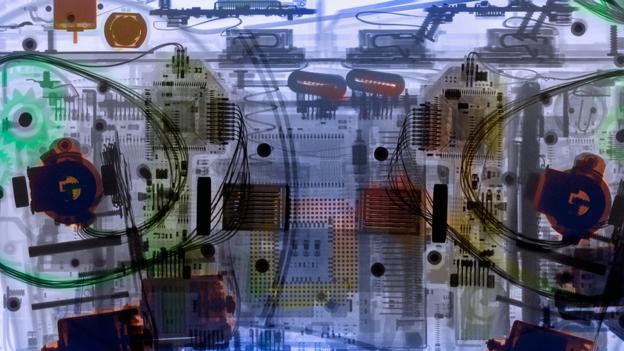A cheap test which could detect even low levels of viruses and some cancers has been developed by UK researchers.
The colour of a liquid changes to give either a positive or negative result. The designers from Imperial College London say the device could lead to more widespread testing for HIV and other diseases in parts of the world where other methods are unaffordable.
Early testing showed the presence of markers of HIV and prostate cancer could be detected. However, trials on a much larger scale will be needed before it could be used clinically. The prototype, which needs wider testing, is described in the journal Nature Nanotechnology.
Prof Molly Stevens told the BBC: "This method should be used when the presence of a target molecule at ultra-low concentration could improve the diagnosis of disease.
The researchers expect their design will cost 10 times less than current tests. They say this will be important in countries where the only options are unaffordable.
Fellow researcher Dr Roberto de la Rica said: "This test could be significantly cheaper to administer, which could pave the way for more widespread use of HIV testing in poorer parts of the world."
Innovative news from the world of technology. Objective is to keep a history of interesting new technology and see if it came to fruition.
Tuesday, October 30, 2012
Thursday, October 18, 2012
Chinese 'Thunder God' plant could crush cancer
Scientists believe a plant used for centuries in Chinese medicine may offer a cure for the pancreatic cancer that afflicted Apple talisman Steve Jobs and many others worldwide each year.
Boffins from University of Minnesota’s Masonic Cancer Center have been testing Minnelide, a drug extracted from the lei gong ten or ‘thunder god vine’ (Tripterygium wilfordii) and presented their results in the Science Translational Medicine on Thursday. For those in the know, Minnelide is a water soluble form of triptolide, a diterpenoid.
When tested on mice it was found to be “highly effective in reducing pancreatic tumour growth” and “shows promise as a potent chemotherapeutic agent against pancreatic cancer”, according to the research.
“This drug is just unbelievably potent in killing tumor cells,” Ashok Saluja, vice chairman of research at the centre, told Bloomberg.
Source: http://www.theregister.co.uk/2012/10/18/boffins_cure_pancreatic_cancer_chinese_medicine_thunder_god/
Boffins from University of Minnesota’s Masonic Cancer Center have been testing Minnelide, a drug extracted from the lei gong ten or ‘thunder god vine’ (Tripterygium wilfordii) and presented their results in the Science Translational Medicine on Thursday. For those in the know, Minnelide is a water soluble form of triptolide, a diterpenoid.
When tested on mice it was found to be “highly effective in reducing pancreatic tumour growth” and “shows promise as a potent chemotherapeutic agent against pancreatic cancer”, according to the research.
“This drug is just unbelievably potent in killing tumor cells,” Ashok Saluja, vice chairman of research at the centre, told Bloomberg.
Source: http://www.theregister.co.uk/2012/10/18/boffins_cure_pancreatic_cancer_chinese_medicine_thunder_god/
Thursday, October 11, 2012
Robots: Can biohybrid model sink or swim?
“The idea is to build a part biological, part machine robot,” says Daniel Frankel, a chemical engineer at Newcastle University and one of the lead scientists for the project. “We’re going to do that using genetic engineering – we’re changing the way the cells work so they can be read by electronics.” This ambitious project, which began in 2009 aims to build a swimming robot with cells that have been genetically engineered to act like eyes, cells that detect chemicals, and muscles that contract, says Frankel. “All of these components will eventually work together like an artificial organism.”
Frankel is now using the same approach to build the robot’s chemical sensors, working with Christopher Voigt, a biological engineer at MIT, to engineer hamster cells that give off nitric oxide in the presence of certain chemical compounds. The release of nitric oxide will allow the modified mammalian cells to communicate with Cyberplasm’s electronic “brain”.
The micro-robot, dubbed “Cyberplasm” could then perform hazardous underwater tasks, such as looking for submerged mines, and explore worlds inaccessible to humans.
Source: http://www.bbc.com/future/story/20121010-sink-or-swim-for-biohybrid-robot
Link: http://cyberplasm.net/
Frankel is now using the same approach to build the robot’s chemical sensors, working with Christopher Voigt, a biological engineer at MIT, to engineer hamster cells that give off nitric oxide in the presence of certain chemical compounds. The release of nitric oxide will allow the modified mammalian cells to communicate with Cyberplasm’s electronic “brain”.
The micro-robot, dubbed “Cyberplasm” could then perform hazardous underwater tasks, such as looking for submerged mines, and explore worlds inaccessible to humans.
Source: http://www.bbc.com/future/story/20121010-sink-or-swim-for-biohybrid-robot
Link: http://cyberplasm.net/
Wednesday, October 03, 2012
Bee brains help to make robots smarter
Honey bee brains could soon be helping robots act more independently.
The way that bees smell and see is being studied in a £1m project to produce a simulation of the insect's sensory systems. The simulated bee brain will then be used by a flying robot to help it make decisions about how to navigate safely.
The researchers, which involves scientists from the Universities of Sheffield and Sussex, aims to create models of the neural systems in a bee's brain that helps it make sense of what it sees and smells. Dr James Marshall, a computer scientist at the University of Sheffield co-ordinating the project, said simulating a brain was one of the "major challenges" of artificial intelligence.
Source: http://www.bbc.com/news/technology-19799806
Subscribe to:
Posts (Atom)

